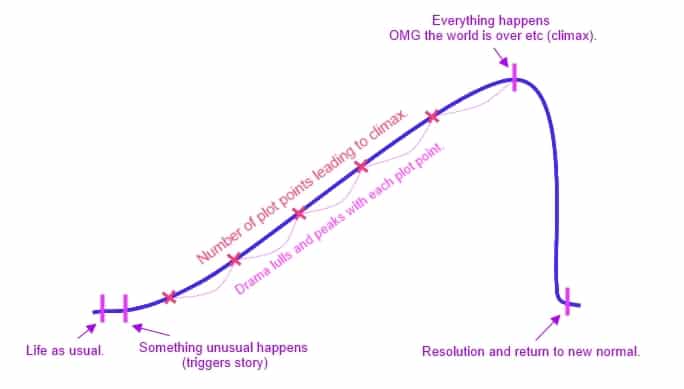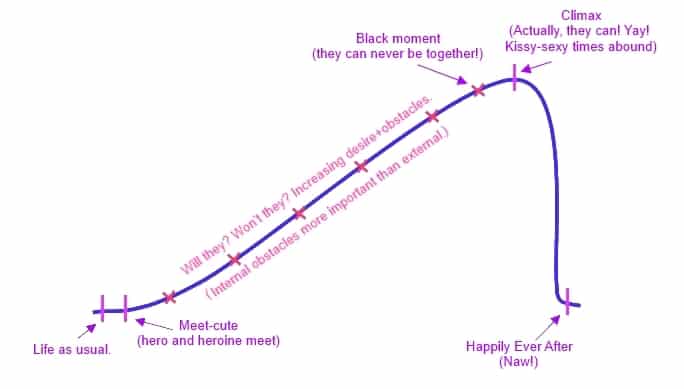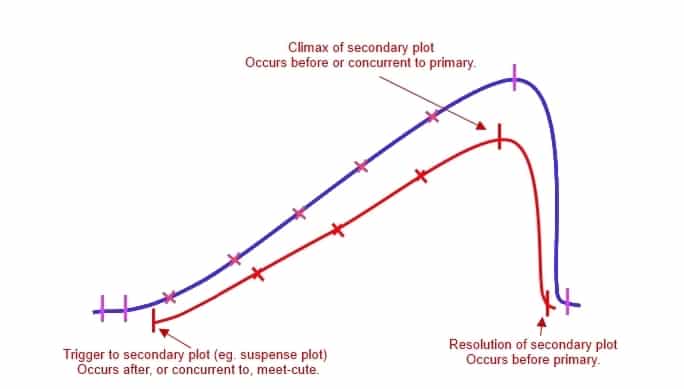When writing fiction there are no hard and fast rules, but there are some guidelines you ought to be aware of. In terms of plotting, whether you are a plotter or a pantser, there is an essential basic arc that you will want your narrative to fit.
The Basic Plot Arc (or Story Arc):
In a basic plot arc, your story should look something like this:
Essential aspects to remember in a basic plot:
- Your plot begins with an event that changes everything. This event triggers a number of increasingly dramatic plot points, which are connected and which lead to an ultimate crisis and resolution.
- Additional dramatic points that do not contribute to the plot itself are a distraction. Everything must result in something.
The Romance Plot Arc:
In a romance plot arc, the requirements of your narrative structure become a little more specific. It should look something like this:
Essential aspects to remember in a romance plot:
- Heroine and hero must meet quickly, after setting up normal life, thus triggering the main plot.
- The story must progress with a series of midway plot points that increase in drama and, most importantly, focus on the romance, leading to the romance crisis and resolution. Will they or won’t they end up together? That’s the point of a romance. Each plot point should be heightening the tension over that question, as well as the desire between your two characters.
- Internal obstacles (emotional conflicts) are more important than external obstacles. External obstacles (secondary characters/plots) might heighten internal ones, but the internal obstacles should be the focus.
- Hero and heroine must be in-scene together (even if they are in conflict), or thinking about each other, for the majority of the novel. When they aren’t together, the reader is bored.
- Typically the climax in a romance is achieved by your heroine and/or hero making a decision to sacrifice something for love.
- It’s all about your two main characters (and their feelings), everything else is secondary.
The Secondary Plot Arc:
Of course, a lot of romance stories have a secondary plot, whether it be a suspense plot, a paranormal plot, or a plot about related secondary characters (etc). When we add a secondary plot into the mix, the story gets a bit more complex.
Although it should hold less focus than your main romance plot, your secondary plot needs to be just as cohesive and take a similar structure. It should look something like this:
Essential aspects to remember in a secondary plot:
Your secondary storyline must have a similar structure to your primary plot. You need a trigger, a build up to a climax and a resolution. Most importantly, your trigger, build up, climax and resolution need to be related and lead into each other.
- Plot points that do not lead anywhere are a distraction and should be cut.
- Try to have your secondary storyline feed into your romance storyline.
- Make sure all your plot lines are resolved by the end.
TOP PRIORITIES FOR A ROMANCE PLOT ARC:
- Plot your romance so that it is the focus of your storyline.
- Ensure that there are obstacles and plot points that affect the romance.
- Ensure that your secondary plot is cohesive and resolved, feeding rather than detracting from the romance plot.
Happy writing!
Holly Kench of Visibility Fiction




